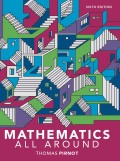
In constructing the number x in Example 4, how would you decide what to put in the 99th place?
Example 4A Cardinal Number Greater Than
We will reproduce Cantor’s argument that the seat of real numbers between 0 and 1 has cardinal number greater than
Although we would not actually know what the listing would be, for the sake of argument, let us assume that we had listed all the numbers between 0 and 1 as follows:
Although we have assumed that all numbers between 0 and 1 are listed, we will now show you how to construct a number x between 0 and 1 that is not on this list. We want x to be different from the first number on the list, so we will begin the decimal expansion of x with a digit other than a 6 in the tenths place, say x = 0.5…Because we don’t want x to equal the second number on the list, we make the hundredths place not equal to 3, say 4, so far, x=.54…(For this argument to work, we will never switch a number to 0 to 9.) Continuing this pattern, we make sure that x is different from the third number in the third decimal place, say 3 and different from the fourth number in the fourth decimal place, make it 5, and so on. At this point, x = 0.5435… By constructing x in this fashion, it cannot be the first number on the list, or the second, or the third, and so on. In fact, x will differ from every number on the list in at least one decimal place, so it cannot be any of the numbers on the list. This means that our assumption that we were able to match the numbers between 0 and 1 with the natural number is wrong So the cardinal number of this set is not
Want to see the full answer?
Check out a sample textbook solution
Chapter 2 Solutions
Mathematics All Around (6th Edition)
Additional Math Textbook Solutions
Pathways To Math Literacy (looseleaf)
College Algebra (7th Edition)
Elementary Statistics: A Step By Step Approach
University Calculus: Early Transcendentals (4th Edition)
- Use 12.4.2 to determine whether the infinite series on the right side of equation 12.6.5, 12.6.6 and 12.6.7 converges for every real number x.arrow_forwarduse Cauchy Mean-Value Theorem to derive Corollary 12.6.2, and then derive 12.6.3arrow_forwardExplain the focus and reasons for establishment of 12.5.4arrow_forward
- Explain the focus and reasons for establishment of 12.5.3 about alternating series. and explain the reason why (sigma k=1 to infinite)(-1)k+1/k = 1/1 - 1/2 + 1/3 - 1/4 + .... converges.arrow_forwardExplain the key points and reasons for the establishment of 12.3.2(integral Test)arrow_forwardUse identity (1+x+x2+...+xn)*(1-x)=1-xn+1 to derive the result of 12.2.2. Please notice that identity doesn't work when x=1.arrow_forward
 Algebra: Structure And Method, Book 1AlgebraISBN:9780395977224Author:Richard G. Brown, Mary P. Dolciani, Robert H. Sorgenfrey, William L. ColePublisher:McDougal Littell
Algebra: Structure And Method, Book 1AlgebraISBN:9780395977224Author:Richard G. Brown, Mary P. Dolciani, Robert H. Sorgenfrey, William L. ColePublisher:McDougal Littell College AlgebraAlgebraISBN:9781305115545Author:James Stewart, Lothar Redlin, Saleem WatsonPublisher:Cengage Learning
College AlgebraAlgebraISBN:9781305115545Author:James Stewart, Lothar Redlin, Saleem WatsonPublisher:Cengage Learning Elementary Geometry For College Students, 7eGeometryISBN:9781337614085Author:Alexander, Daniel C.; Koeberlein, Geralyn M.Publisher:Cengage,
Elementary Geometry For College Students, 7eGeometryISBN:9781337614085Author:Alexander, Daniel C.; Koeberlein, Geralyn M.Publisher:Cengage,- Algebra & Trigonometry with Analytic GeometryAlgebraISBN:9781133382119Author:SwokowskiPublisher:Cengage



